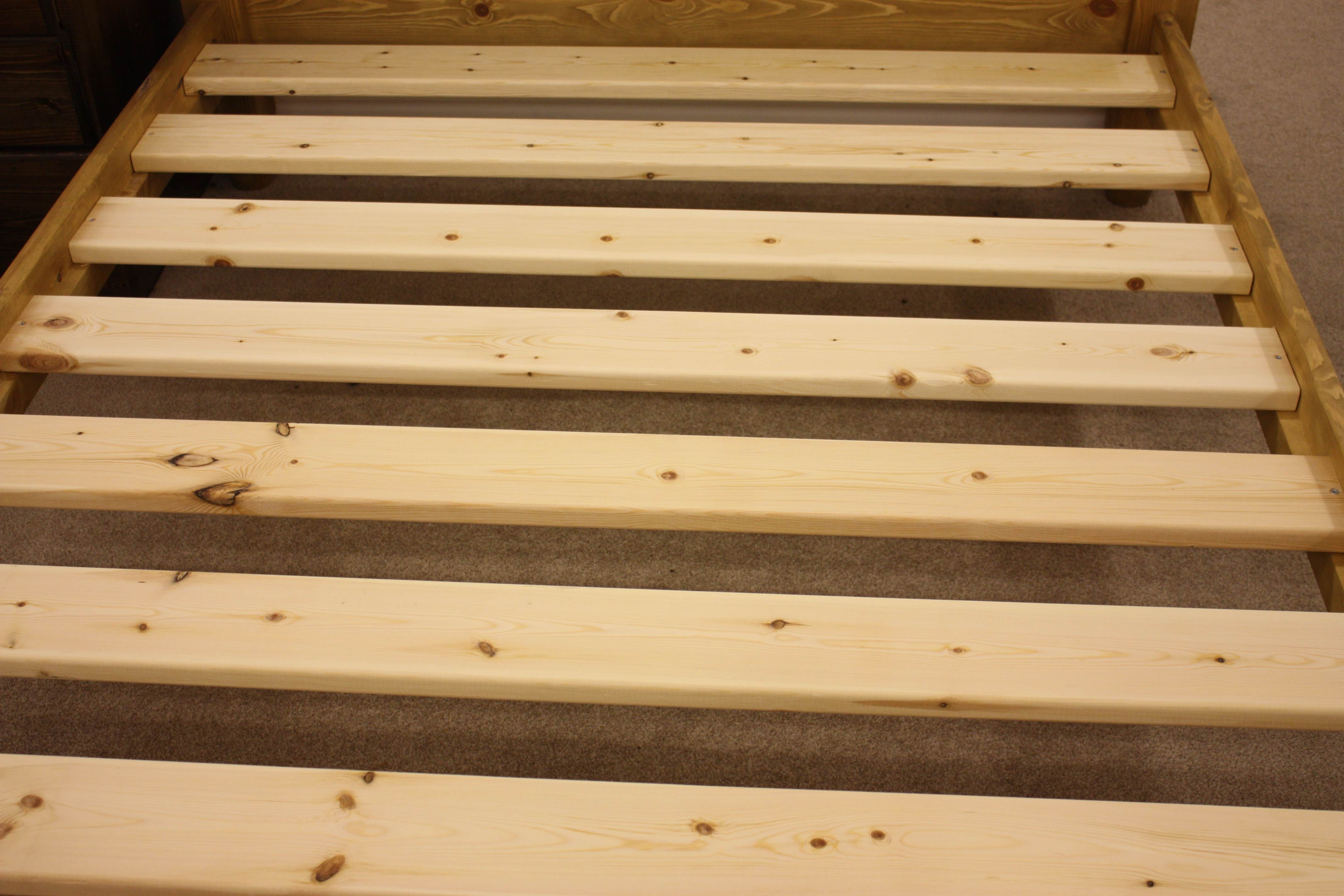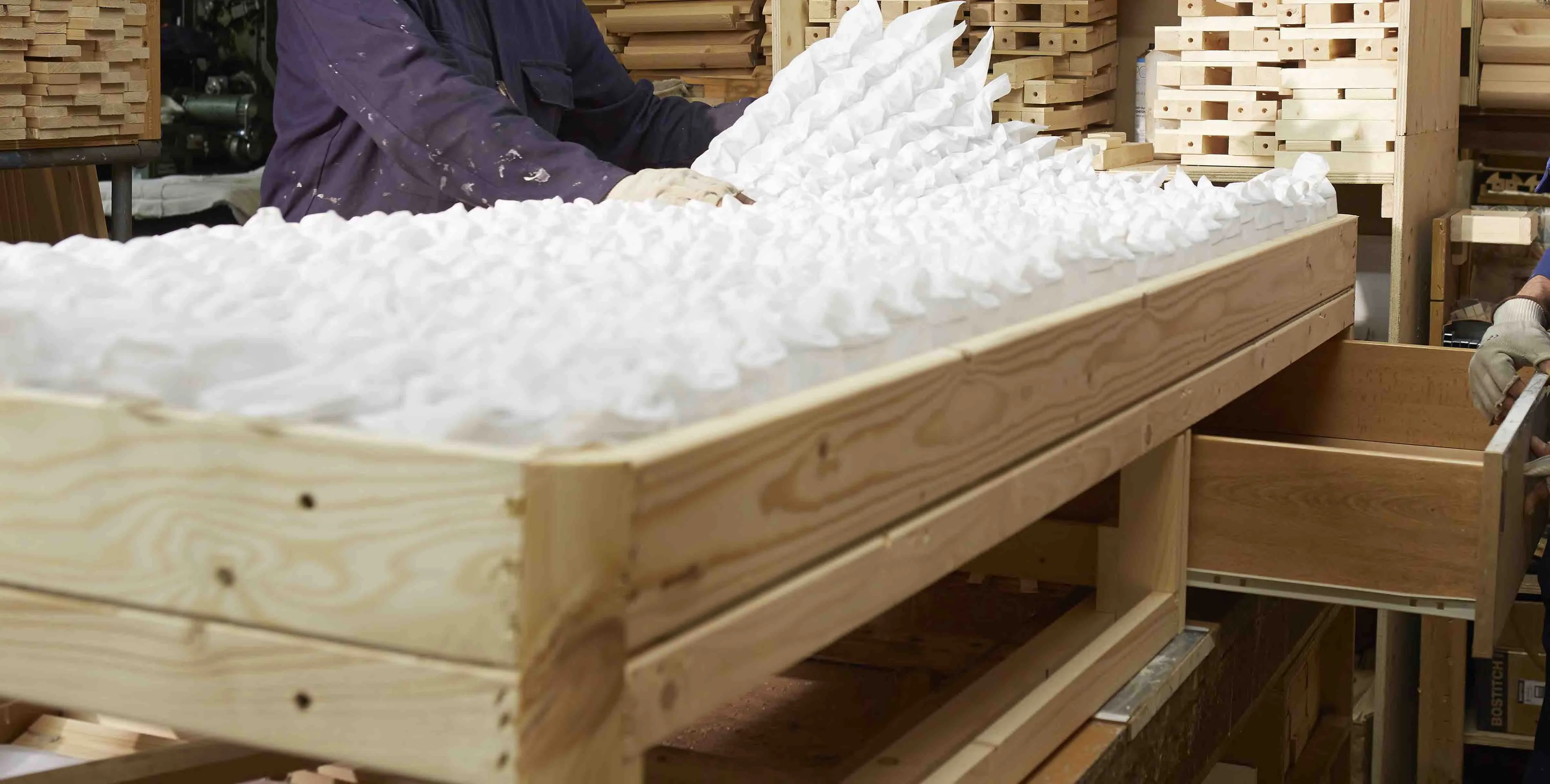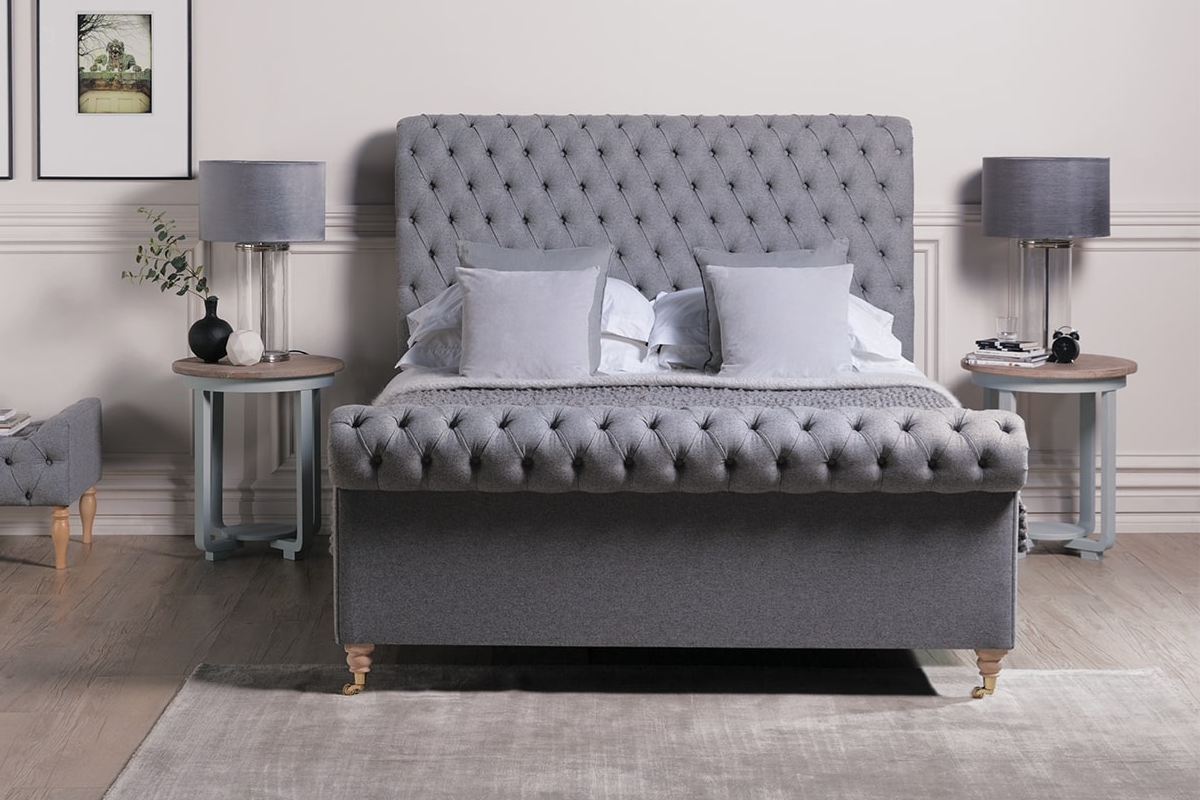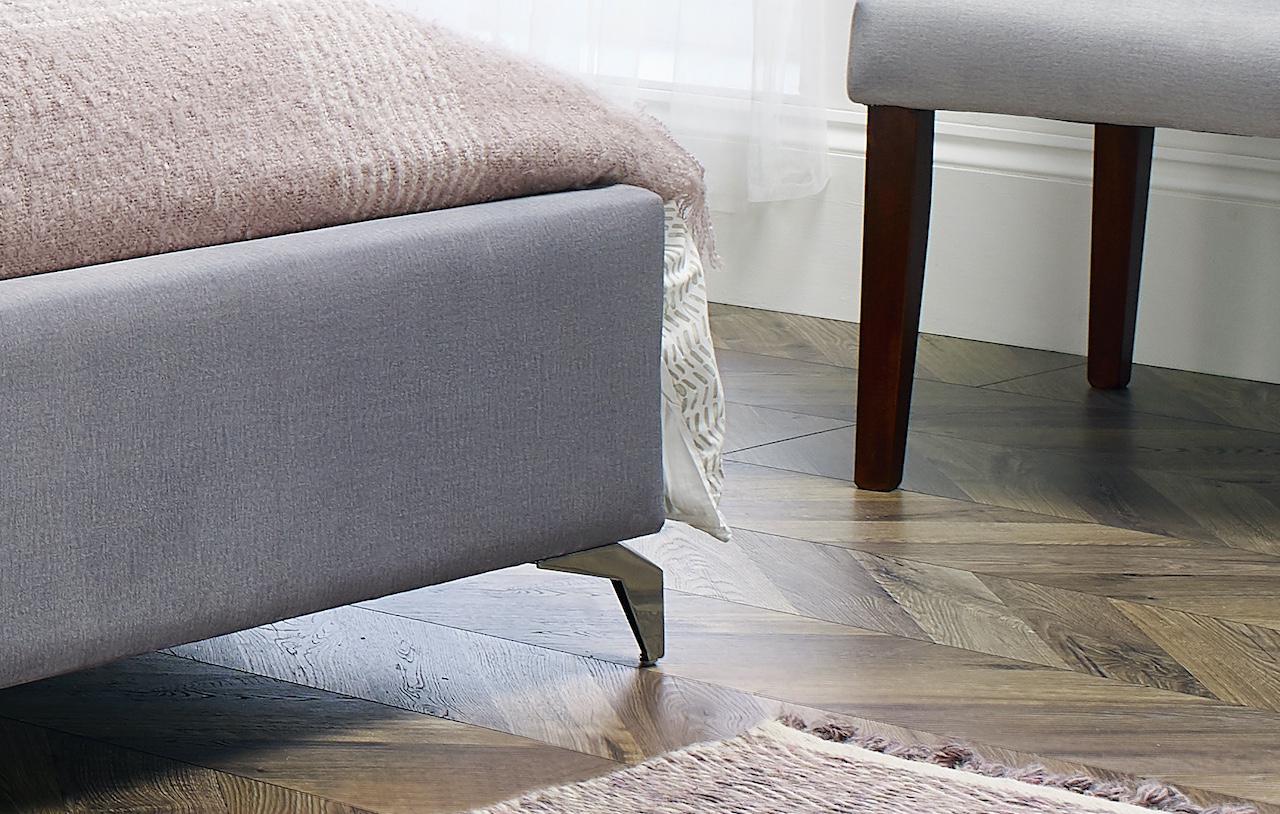Bases & Headboards
October 2020Bed Frames and Bedsteads Explained: 3 tips to pick the perfect bed base
Bed Frame Top Tips
Bed frames are the next big thing for interior bedroom styling and design. They can create a real statement piece in your bedroom. However, not all bed frames are created the same. Whilst they may look nice there is definitely some key bed frame features that you need to look at more closely to ensure you choose the right quality bedstead.
We are going to explain the 3 things you need to know about Bed frames.
- Bed frame supports explained – avoiding slats
- Bed frame timber construction
- Upholstery details on bed frames
1. Bed frame support slats vs bed pads
The most important thing when considering buying a new bed frame or bedstead is to check the mattress support type. There are two methods of providing support for a mattress in a bed frame or bedstead.
- Slatted bed frame mattress support (entry-level)
- Upholstered timber platform bed pad (high end)
The sad fact is that 99% of all bed frames use the cheapest method of support in their mattress bases. Wooden slats. They are the most common entry-level bed base support type for mattresses. This is because they are cheap, easy for buyers to assemble and hard to damage during transit when boxed. They are not used for the best support a bed frame can have but because it is easier for sellers to produce and ship them out.

The issue with bed base slats is that more often than not they can cause more damage than good to a quality mattress. This is down to the fact that they don’t offer enough consistent support, in particular for more expensive heavyweight mattresses.
The problems with slats:
- They are often made from crude rough timber which can nip, tear or snag on your mattress
- They are usually spaced too far apart, to further save costs, meaning the gaps between the gaps cause the mattress to sag in between them
- They can move during the night causing creaks and squeaks as you turn over
- Metal slats are often circular causing undue pressure on your mattress at each slat interval leading to inconsistencies in terms of mattress comfort. They have a habit of bending after a year or two.
We often advise customers who have unfortunately chosen this type of bed frame support to board over the slats with MDF or plywood. This is to provide a more consistent even surface. However, this also requires a duvet or material cover to stop snags and make sure that you’re quality mattress doesn’t get damaged.
Ideally, you should avoid slatted bed frames and opt for a fully upholstered platform base pad instead. Meaning no dramas with gaps, snags or squeaks during the night!

Slatted bed frames should be avoided as they offer inadequate support
Look for an upholstered base pad instead


2. Bed frame timber type
The next important consideration when buying a bed frame is to know exactly what timber your frame is made from. This timber forms the structural integrity of the bed frame and bed base. A bed frame can be upholstered in the finest material but if underneath there’s nothing but cheap offcuts, it will soon start to deteriorate.
Many retailers will do their best to dodge this question. Why? Because entry-level bedframes may be made of cheap softwood or fibreboard panels ie recycled glued bits of wood shavings. The issue with these materials is that more often than not they are made for very lightweight mattresses and sleepers. There is nothing wrong with fibre board for light base applications but you shouldn’t be paying more than £300 for a bed frame made of this.
If you add a high-quality mattress that may weight 60kg plus onto one of these cheap bed frames then place two sleepers on top, suddenly the bedframe can become unstable. Often we hear from customers who complain their bedframes are bowing or bending and how they can fix this. The sad fact is if you have purchased a cheap recycled bed frame base that starts to sag, its game over. There is very little you can do if the fundamental support in your bed frame is inadequate for the weight of your mattress and sleepers. Contrary to the number of google results for ‘fixing a broken divan’, once the support frame is damaged there is no easy fix.

The highest quality bed frame construction method will use hardwood joints and supports. This will be braced by upholstered panels of high-quality MDF for strength and consistency. Always drilled and jointed appropriately to provide lasting support in your bed frame at night.
Look for descriptions that identify the timber used as:
- Cedar
- Beech
- Oak
It’s time to have a look at the last area when buying a new bed frame and that is the quality of the bedframe upholstery.

3. Upholstery quality, tailoring and detailing.
If you’ve done your research you’ll have identified a bed frame that doesn’t use slats and features hardwood joints. You’re on the home stretch! The last area to look at in detail is the upholstery and detailing used to cover the bed frame. This is where you can go to town in choosing literally thousands of fabric colours, finishes and options. A fully upholstered bed frame will be plump and not display any creases or uneven seams. Make sure you check the corners of a bed frame and headboard detailing. This is often where misaligned hems, dodgy seams or inconsistencies appear. The upholstered bed frame should be stitched and stapled where appropriate. Never simply glued to the frame like cheaper models.

Usually, the upholstery is padded with a synthetic wadding in most bed frames which is perfectly acceptable to keep its loft and feel. Usually, this wadding is polyester-based. Super high-end bed frames may use wool as the wadding but these frames will be in excess of £3000+ each given the number of natural fibres needed and expense of such fibres.
Bed frames can also come with a number of different bed legs which can help accentuate the style of the frame and your bedroom.
Quality Bed legs for bed frames are often made of:
- Wood (Hardwood usually thats stained)
- Metal (Aluminium, Chrome or Steel)
Plastic legs on bed frames should be avoided as these scratch easily and often are not strong enough to support the weight of the frame and mattress. Castors may also be used but bear in mind on hardwood floors then can move about considerably during the night if you fidget a lot. Sometimes a solid leg is preferable on wooden or tiled floors.

Access Issues for Bed Frames
One last point to mention before you buy a new bed frame is to make sure that there’s enough access in your property for your newly sized bed frame. Bedframes may arrive in a number of separate components that are then bolted or clipped together with strong supports. However, the headboard is usually a one-piece and more often than not the largest part of the bed frame combination. Checking is important as many retailers will not allow a bed frame back for a refund if you’ve failed to measure up correctly for access.
Always check the dimensions of the headboard. For example, our largest bed frame the Gatsby in a kingsize has a headboard height of 1.5 meters. You can check the dimensions by looking at the height of the bed frame which usually refers to the headboard.
Example Base Frame Dimensions for our Gatsby
Single – W: 112cm H: 150cm L: 215cm
Small Double – W: 143cm H: 150cm L: 215cm
Double -W: 158cm H: 150cm L: 220cm
Kingsize – W: 173cm H: 150cm L: 220cm
Super Kingsize -W: 204cm H: 150cm L: 220cm
90 degree bends, and returns in stairwells along with low ceilings can all mean that access is insufficient for a bed frame. If you’re looking at buying one of our bed frames then please get in touch with our team with any photos if you’re uncertain about access. If you have really restricted access then our Divan bases can be made into 4 pieces and headboards can often (depending on design) be split into two and then paired up.
| Bed & Mattress Sizes UK | Metric Dimensions | Imperial Dimensions |
|---|---|---|
| Small Single | 80cm x 190cm | 2’ 6” x 6’3” |
| Single | 90cm x 190cm | 3′ x 6’3″ |
| Small Double | 120cm x 190cm | 4″ x 6’3 |
| Double | 135cm x 190cm | 4’6″ x 6’3″ |
| Continental Double | 140cm x 200cm | 4’7” x 6’6” |
| King | 150cm x 200cm | 5′ x 6’6″ |
| Continental King | 160cm x 200cm | 5’3″ x 6’6″ |
| Extra King | 180cm x 190cm | 6’0 x 6’3 |
| Super King | 180cm x 200cm | 6′ x 6’6″ |
| *All furniture dimensions are covered by a tolerance of up to 2cm. |
Summary
Bed frames can add a real wow factor to your bed frame. Taking a mundane base and making it absolutely fabulous. By following our guide you will avoid being tricked by cheap bed frames that will often only last a few years before they start to deteriorate. By being careful in your selection you can avoid the issues often found with slatted bed frames and uncomfortable nights sleep.
Bed frames come in thousands of fabric selections meaning you can tailor your bed frame to suit your exacting home decor requirements. After all, why shouldn’t your bedroom be fabulously opulent?
Sleep well!

Dreaming of the perfect nights sleep?

Ask us a question
There are over 6000 questions and answers submitted by you on all questions about mattresses and bed problems. Enter a keyword such as Vi Spring, John Lewis beds, bad back or Memory Foam and see if your question has already been answered.
If you can’t find an answer in knowledge hub, ask a new question. We aim to respond to all questions within one working day.
Newsletter
Enter your email to join our newsletter. We’ll send you occasional news and mattress expertise.

